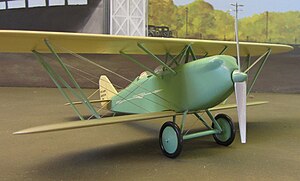Pitcairn PA-2 Sesquiwing
Model of a 1926 PA-2 on display at the EAA Airventure Museum
Role
BiplaneType of aircraft
National origin
United States of America
Manufacturer
Pitcairn Aircraft Company
Designer
Agnew E. Larson
First flight
1926
Introduction
1926
The Pitcairn PA-2 Sesquiwing "Arrow" is an early biplane designed for air racing and commercial airmail service.[1]
Design
The Sesquiwing featured a quick change motor mount to accommodate a Curtiss C-6 or Curtiss OX-5 engine, and wheel fairings for speed.[2]
Operational history
A specially built PA-2 was flown by Jim Ray in the 1926 Ford National Reliability Air Tour . It placed second in a race for engines under 800 cubic inches displacement, then it had its engine swapped to an OX-5 for a race the next day, and again back to a Curtiss C-6 engine the next day to win the Detroit race.[3]
Specifications (Pitcairn PA-2 Sesquiwing - C-6 engine)
Pitcairn PA-2 Sesquiwing with OX-5 motor. 3-view drawing from Le Document aéronautique February,1927 Data from The Pitcairn Sesqui-Wing[4]
General characteristics
Crew: 1Capacity: 2 passengersLength: 22 ft 6 in (6.86 m)Upper wingspan: 32 ft 0 in (9.75 m)Lower wingspan: 24 ft 8+ 1 ⁄2 in (7.531 m)Height: 8 ft 4 in (2.54 m)Wing area: 219.8 sq ft (20.42 m2 )Empty weight: 1,492 lb (677 kg)Gross weight: 2,246 lb (1,019 kg)Powerplant: 1 × Curtiss C-6 , 160 hp (120 kW)Performance
Maximum speed: 145 mph (233 km/h, 126 kn)Cruise speed: 120 mph (190 km/h, 100 kn)Stall speed: 60 mph (97 km/h, 52 kn)Range: 360 mi (580 km, 310 nmi)Endurance: 3 hrService ceiling: 20,000 ft (6,100 m)

